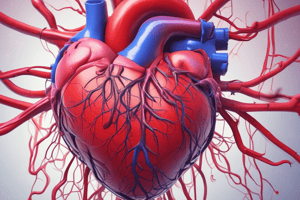Podcast
Questions and Answers
What is the main mechanism behind myogenic autoregulation of blood flow?
What is the main mechanism behind myogenic autoregulation of blood flow?
- Increased tissue metabolism
- Accumulation of vasodilator metabolites
- Vascular smooth muscle response to stretch (correct)
- Release of vasodilator prostaglandins
Which of the following is not an example of a vasodilator metabolite that contributes to metabolic autoregulation?
Which of the following is not an example of a vasodilator metabolite that contributes to metabolic autoregulation?
- K+ (correct)
- Adenosine
- CO2
- Histamine
How does increased tissue metabolism affect arterioles and precapillary sphincters in metabolic autoregulation?
How does increased tissue metabolism affect arterioles and precapillary sphincters in metabolic autoregulation?
- Causes relaxation (correct)
- Induces hyperpolarization
- Has no effect
- Causes vasoconstriction
What happens when hypoxia occurs in the context of metabolic autoregulation?
What happens when hypoxia occurs in the context of metabolic autoregulation?
Which vasodilator metabolite is especially found in the brain and skin for metabolic autoregulation?
Which vasodilator metabolite is especially found in the brain and skin for metabolic autoregulation?
What effect does local changes in interstitial fluid osmolarity have on smooth muscle in autoregulation?
What effect does local changes in interstitial fluid osmolarity have on smooth muscle in autoregulation?
What is the main site of peripheral resistance (PR) in the circulation?
What is the main site of peripheral resistance (PR) in the circulation?
In the context of blood flow regulation, what condition leads to large reductions in blood flow due to mild narrowing?
In the context of blood flow regulation, what condition leads to large reductions in blood flow due to mild narrowing?
What physiological process allows small changes in arteriolar diameter to lead to relatively large changes in blood flow?
What physiological process allows small changes in arteriolar diameter to lead to relatively large changes in blood flow?
What type of blood flow involves all particles flowing parallel to the wall of the tube, but not at the same velocity?
What type of blood flow involves all particles flowing parallel to the wall of the tube, but not at the same velocity?
Which factor leads to blood flow changes aimed at increasing the blood supply to active tissues?
Which factor leads to blood flow changes aimed at increasing the blood supply to active tissues?
What type of flow results from changes in blood velocity turning streamline flow into a more chaotic state?
What type of flow results from changes in blood velocity turning streamline flow into a more chaotic state?
What factors determine blood flow in a vessel?
What factors determine blood flow in a vessel?
How does increased hematocrit affect blood flow in a vessel?
How does increased hematocrit affect blood flow in a vessel?
Which of the following is a mechanism of metabolic autoregulation of blood flow?
Which of the following is a mechanism of metabolic autoregulation of blood flow?
How does the length of a vessel affect blood flow?
How does the length of a vessel affect blood flow?
Which factor has the most significant effect on the resistance encountered by blood in a vessel?
Which factor has the most significant effect on the resistance encountered by blood in a vessel?
What role do vasoactive substances play in arteriolar diameter and blood flow?
What role do vasoactive substances play in arteriolar diameter and blood flow?
Flashcards are hidden until you start studying




